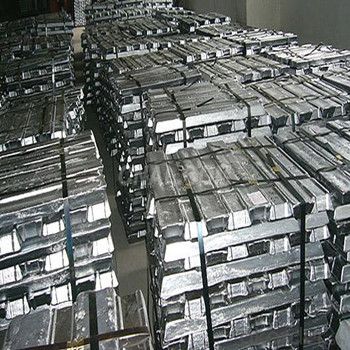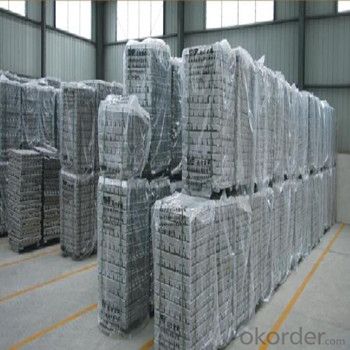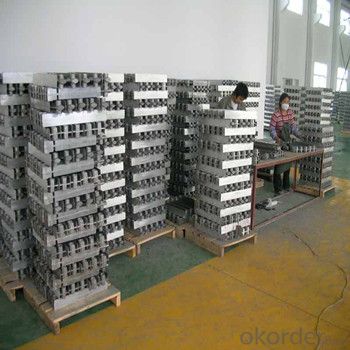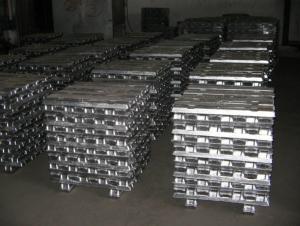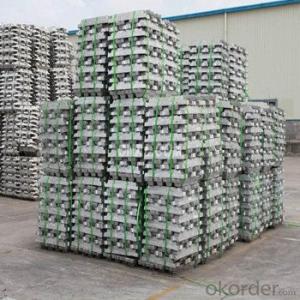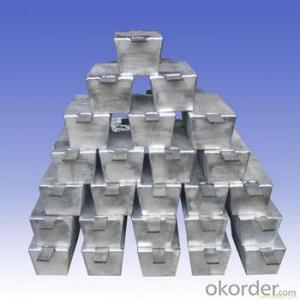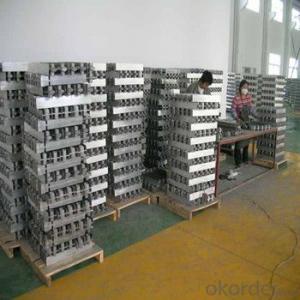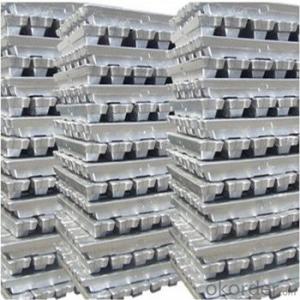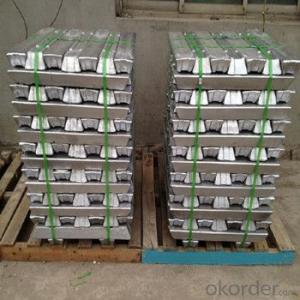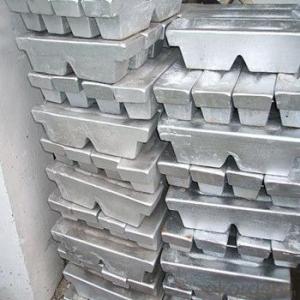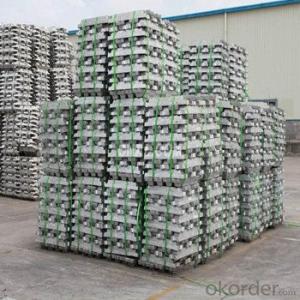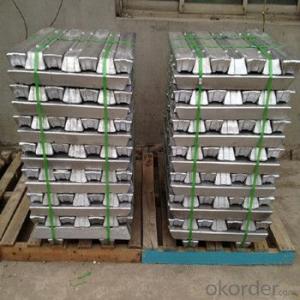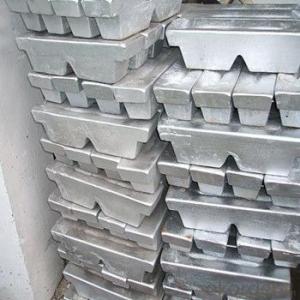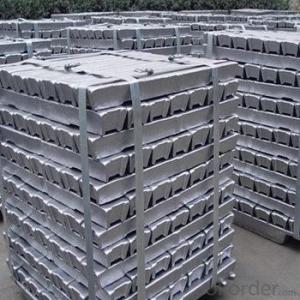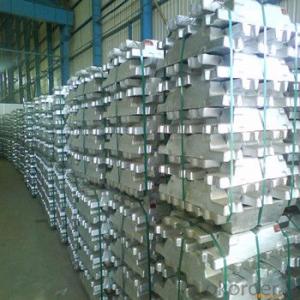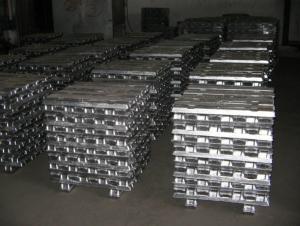Aluminum Ingot 99.7% From Factory Directly Supply With Cheap Price
- Loading Port:
- China main port
- Payment Terms:
- TT OR LC
- Min Order Qty:
- 1000 m.t.
- Supply Capability:
- 10000 m.t./month
OKorder Service Pledge
OKorder Financial Service
You Might Also Like
Pure Aluminum Ingot Used for Industry
1.Structure of Aluminum Ingot Description
Aluminum ingot for remelting is produced by molten salt electrolysis method using alumina and cryolite. Products meet the national standard GB/T1196-2002. The surface of ingot is clean and smooth. An ingot is a piece of material, usually metal, that is cast into a shape suitable for further processing. Insteelmaking, it is the first step among semi-finished casting products. Ingots usually require a second procedure of shaping, such as cold/hot working, cutting, or milling to produce a useful final product.
2.Main Features of the Aluminum Ingot
•High Purity
•High strength
•Fast melting
•Best price
•Good after-service
3. Aluminum Ingot Images
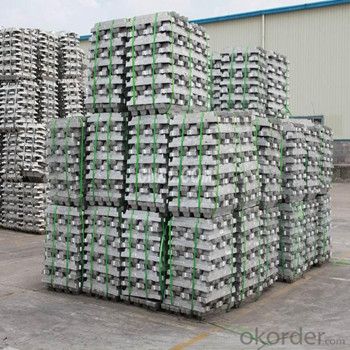
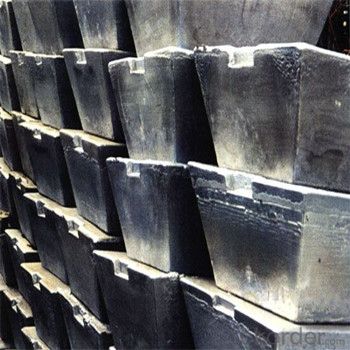
4. Aluminum Ingot Specification
Grade | Chemical Composition % | |||||||||
Al≥ | impurities ≤ | |||||||||
Si | Fe | Cu | Ga | Mg | Zn | Mn | others | Sum | ||
Al99.9 | 99.90 | 0.50 | 0.07 | 0.005 | 0.02 | 0.01 | 0.025 | - | 0.010 | 0.10 |
Al99.85 | 99.85 | 0.80 | 0.12 | 0.005 | 0.03 | 0.02 | 0.030 | - | 0.015 | 0.15 |
Al99.7 | 99.70 | 0.10 | 0.20 | 0.010 | 0.03 | 0.02 | 0.030 | - | 0.030 | 0.30 |
Al99.6 | 99.60 | 0.16 | 0.25 | 0.010 | 0.03 | 0.03 | 0.030 | - | 0.030 | 0.40 |
Al99.5 | 99.50 | 0.22 | 0.30 | 0.020 | 0.03 | 0.05 | 0.050 | - | 0.030 | 0.50 |
Al99.00 | 99.00 | 0.42 | 0.50 | 0.020 | 0.03 | 0.05 | 0.050 | - | 0.050 | 1.00 |
5.FAQ of Aluminum Ingot
We have organized several common questions for our clients,may help you sincerely:
①How about your company?
A world class manufacturer & supplier of castings forging in carbon steel and alloy steel,is one of the large-scale professional investment casting production bases in China,consisting of both casting foundry forging and machining factory. Annually more than 8000 tons Precision casting and forging parts are exported to markets in Europe,America and Japan. OEM casting and forging service available according to customer’s requirements.
②How to guarantee the quality of the products?
We have established the international advanced quality management system,every link from raw material to final product we have strict quality test;We resolutely put an end to unqualified products flowing into the market. At the same time, we will provide necessary follow-up service assurance.
③How long can we receive the product after purchase?
In the purchase of product within three working days, We will arrange the factory delivery as soon as possible. The pecific time of receiving is related to the state and position of customers.Commonly 7 to 10 working days can be served.
- Q: Are aluminum alloy ADC12 and aluminium ingot ADC12 the same?What's the difference? The price you see in Ali looks different
- Friends, you ask what is the same thing, the price is certainly not the same, the aluminum ingot price is floating
- Q: Can aluminum ingots be customized for specific applications?
- Yes, aluminum ingots can be customized for specific applications. Aluminum is a highly versatile metal that can be easily manipulated to meet various requirements. The customization process typically involves alloying the aluminum with other elements to enhance its properties such as strength, hardness, corrosion resistance, and thermal conductivity. Additionally, the ingots can be subjected to various heat treatment processes like annealing, quenching, and tempering to further modify their properties. This allows for the production of aluminum ingots that are tailored to specific applications, ranging from automotive parts and aerospace components to construction materials and consumer products.
- Q: What are the different grades of aluminum ingots?
- Aluminum ingots come in various grades, each possessing distinct properties and applications. The commonly known grades comprise: 1. Pure Aluminum (99%+): This grade represents the elemental form of aluminum and possesses remarkable malleability, lightness, and resistance to corrosion. It finds extensive utilization in scenarios necessitating high electrical conductivity, such as electrical wiring and transmission lines. 2. Aluminum Alloys: These grades consist of aluminum blended with other elements like copper, magnesium, silicon, or zinc, to enhance specific characteristics. For instance, aluminum alloys containing copper are renowned for their exceptional strength and resistance to corrosion, rendering them ideal for structural components within the aerospace and automotive industries. 3. Cast Aluminum: This grade is produced through the casting process and is commonly employed in the production of engine parts, automotive wheels, and other demanding applications that prioritize strength and durability. 4. Wrought Aluminum: Wrought aluminum ingots experience a shaping process, such as rolling or extrusion, to create tailored forms like sheets, plates, or bars. This grade is frequently utilized in the construction sector for structural elements like beams, columns, and facade systems. 5. High-Strength Aluminum: These grades are engineered to possess superior strength while retaining good formability. They find extensive use in industries requiring lightweight, yet sturdy materials, such as aerospace, military, or sporting goods manufacturing. It's worth noting that these grades can be further categorized into specific alloys, each possessing unique characteristics and applications. The selection of an aluminum grade depends on the intended usage, desired properties, and manufacturing requirements of the final product.
- Q: How do aluminum ingots contribute to the circular economy?
- Aluminum ingots contribute to the circular economy by being a key component in the recycling process of aluminum. As a highly recyclable material, aluminum ingots can be melted down and reused multiple times without losing their quality. This reduces the need for extracting and refining new aluminum from raw resources, conserves energy, and minimizes environmental impact. Additionally, the use of recycled aluminum ingots also reduces waste generation and promotes resource efficiency, making it an essential element in the circular economy model.
- Q: How are aluminum ingots used in the production of medical implants?
- Aluminum ingots are used in the production of medical implants as a raw material for casting or forming the implants. The ingots are melted down and shaped into the desired form, which can then be further processed and finished to create various medical implants such as prosthetic limbs, bone plates, or dental implants. The use of aluminum in medical implants provides excellent strength, durability, and corrosion resistance, making it a suitable material for implantable devices.
- Q: 102 non-standard aluminum ingot is like? And ordinary non-standard aluminum ingot what is the difference?
- Nonstandard 102 is aluminium ingot produced by waste aluminium smelting, containing silicon between 8-12%, and remaining iron, zinc and copper content below 1Lower quality requirements for die casting aluminium ingots
- Q: What method does common smelting aluminium ingot adopt now?
- Now, burning the coal oil are slowly eliminated basically, most of the enterprises are using electricity to melt, the intermediate frequency furnace, then the cost of basic equipment in addition to electricity and manpower cost, if furnace factory in Jiangsu and Zhejiang is pretty good, can go to the "Shenguang electric" to go there and see, good quality and price cheap, maintenance or use of electricity can save a large part of the human, but also can reduce air pollution,
- Q: What are the safety precautions when handling aluminum ingots?
- When handling aluminum ingots, it is important to follow certain safety precautions to prevent accidents and ensure the well-being of individuals involved. Here are some safety precautions to consider: 1. Personal Protective Equipment (PPE): Always wear appropriate PPE, including safety glasses, gloves, and protective clothing, when handling aluminum ingots. This helps protect against potential hazards, such as sharp edges, splinters, or contact with the metal. 2. Proper Lifting Techniques: Aluminum ingots can be heavy, so it is crucial to use proper lifting techniques to avoid strains or injuries. Bend at the knees and lift with your legs, keeping your back straight. If the ingot is too heavy, seek assistance or use mechanical aids like cranes or forklifts. 3. Secure Storage and Handling: Store aluminum ingots in a secure manner to prevent them from rolling or falling. Stack them in stable piles, using appropriate stacking equipment if necessary. Avoid storing them near flammable materials or in areas with inadequate ventilation. 4. Fire Safety: Aluminum can ignite if exposed to high temperatures or sparks. Therefore, it is important to keep ingots away from open flames, sparks, or potential ignition sources. Additionally, have fire extinguishers readily available in case of emergencies. 5. Hazard Awareness: Be aware of the potential hazards associated with aluminum ingots, such as sharp edges, friction burns, or the risk of metal fumes. Take necessary precautions to avoid these risks, such as wearing appropriate gloves, using tools with safety guards, or working in well-ventilated areas. 6. Training and Education: Ensure that individuals handling aluminum ingots receive proper training and education on safe handling practices. This includes understanding the potential hazards, knowing how to use equipment properly, and being aware of emergency procedures. 7. Regular Inspections: Regularly inspect aluminum ingots for any signs of damage, such as cracks or sharp edges. Remove any damaged ingots from use, as they can pose an increased risk of accidents or injuries. By following these safety precautions, individuals can minimize the risks associated with handling aluminum ingots and create a safer working environment.
- Q: What are the advantages of using aluminum ingots in electrical applications?
- There are several advantages of using aluminum ingots in electrical applications. Firstly, aluminum is a lightweight material, which makes it easier to handle and transport. This property is particularly beneficial in electrical applications where weight is a concern, such as in the construction of power lines or in the manufacturing of electrical appliances. Secondly, aluminum has excellent electrical conductivity. It conducts electricity almost twice as well as copper, which is commonly used in electrical applications. This high conductivity allows for efficient transmission of electricity and reduces energy losses in electrical systems. Another advantage of aluminum ingots is their corrosion resistance. Aluminum forms a protective oxide layer when exposed to air, which helps to prevent corrosion. This makes aluminum suitable for use in outdoor electrical applications, where exposure to moisture or harsh weather conditions is common. Furthermore, aluminum is a highly recyclable material. It can be melted down and reused multiple times without losing its properties. This not only reduces the need for mining and extraction of new raw materials but also contributes to the sustainability of electrical applications. Lastly, aluminum ingots are cost-effective compared to other materials like copper or steel. Aluminum is abundant in nature and its extraction and processing are relatively less expensive, making it a more affordable option for electrical applications. Overall, the advantages of using aluminum ingots in electrical applications include their lightweight nature, high electrical conductivity, corrosion resistance, recyclability, and cost-effectiveness. These properties make aluminum a preferred choice in various electrical systems, contributing to improved efficiency, durability, and environmental sustainability.
- Q: How are aluminum ingots shaped into different forms?
- The process of aluminum extrusion involves shaping aluminum ingots into various forms. First, the ingot is heated until it becomes molten. Then, the molten aluminum is forced through a specially designed die, which determines the final product's shape and size. The die, acting as a mold, is a hollow profile with the desired shape. Once the molten aluminum passes through the die, it undergoes a cooling process to solidify it into the desired shape. Cooling methods such as air cooling or water quenching can be used, depending on the product's specific requirements. After the aluminum has cooled and solidified, it is cut to the desired length. This can be done during or after the extrusion process, depending on the shape's complexity or the product's requirements. Aluminum extrusion offers a wide range of possibilities for shape production, including solid profiles, hollow sections, tubes, and intricate designs. This highly versatile and efficient process is a popular choice for shaping aluminum into different forms. Moreover, aluminum's lightweight and corrosion-resistant properties make it an ideal material for various applications, ranging from the construction and automotive industries to consumer goods and electronics.
Send your message to us
Aluminum Ingot 99.7% From Factory Directly Supply With Cheap Price
- Loading Port:
- China main port
- Payment Terms:
- TT OR LC
- Min Order Qty:
- 1000 m.t.
- Supply Capability:
- 10000 m.t./month
OKorder Service Pledge
OKorder Financial Service
Similar products
Hot products
Hot Searches
Related keywords



